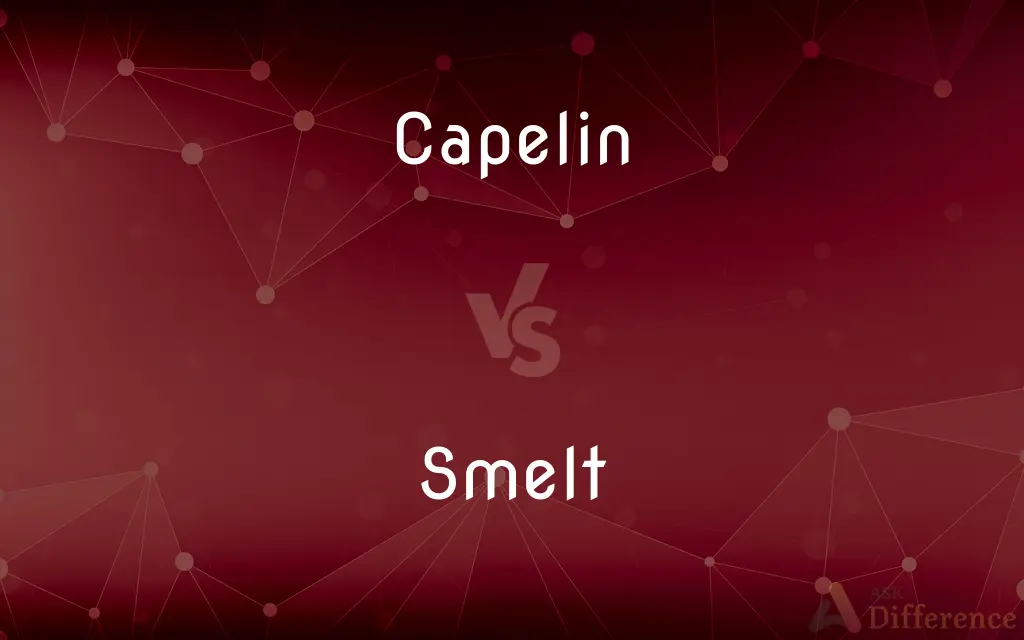Capelin vs. Smelt — What's the Difference?
By Fiza Rafique & Urooj Arif — Updated on March 31, 2024
Capelin are small forage fish known for mass beach spawning, while smelt are valued for their delicate flavor and diverse habitats.

Difference Between Capelin and Smelt
Table of Contents
ADVERTISEMENT
Key Differences
Capelin (Mallotus villosus) are small, pelagic fish primarily found in the cold waters of the Arctic and North Atlantic oceans, playing a crucial role in the marine food web as prey for larger species. Smelt, on the other hand, encompasses several species within the family Osmeridae, found in both freshwater and marine environments across the Northern Hemisphere, known for their slender bodies and silvery scales.
Capelin are especially noted for their unique reproductive behavior, engaging in mass spawning events on beaches, which attract a variety of predators and contribute significantly to local ecosystems. Smelt, while also spawning in large numbers, are known for their annual runs in freshwater rivers, creating seasonal fishing opportunities and cultural events in many regions.
In terms of culinary use, capelin are often consumed whole, including their soft bones, and are popular in sushi dishes in some cultures. Smelt, celebrated for their delicate, sweet flavor, are frequently fried and eaten whole, including the head and tail, especially during smelt fishing festivals in places like the Great Lakes region.
The lifecycle of capelin is closely tied to the sea ice edge, where they feed on plankton, playing a pivotal role in transferring energy from microscopic organisms to larger marine animals. Smelts have adapted to a variety of habitats, with some species living entirely in fresh water, others in the sea, and some migrating between the two for breeding purposes.
Despite their differences, both capelin and smelt face environmental pressures from climate change and overfishing, highlighting the importance of sustainable management practices to ensure their populations remain healthy and continue to support biodiversity.
ADVERTISEMENT
Comparison Chart
Scientific Classification
Mallotus villosus
Family Osmeridae
Habitat
Arctic and North Atlantic oceans
Freshwater and marine environments
Spawning
Mass beach spawning
Spawns in rivers or coastal waters
Diet
Plankton, small invertebrates
Plankton, small fish, and invertebrates
Culinary Use
Consumed whole, popular in sushi
Often fried and eaten whole
Lifecycle
Tied to sea ice edge, short lifespan
Varied, some species migrate for breeding
Threats
Climate change, overfishing
Climate change, habitat loss, overfishing
Cultural Significance
Important forage fish for marine predators
Seasonal fishing events and festivals
Compare with Definitions
Capelin
Vital in supporting larger predatory fish.
The abundance of capelin influences the breeding success of many Atlantic seabirds.
Smelt
Diverse habitats, from freshwater lakes to the ocean.
Some smelt species migrate from lakes to rivers to spawn.
Capelin
Consumed whole, including soft bones.
In many cultures, capelin are dried or smoked for consumption.
Smelt
Faces challenges from habitat loss and overfishing.
Conservation efforts are crucial to maintain healthy smelt populations.
Capelin
Subject to environmental pressures from climate change.
Warming oceans have begun to affect capelin spawning times and locations.
Smelt
A group of small, silvery fish in the Osmeridae family.
Smelt are easily identified by their slender bodies and shiny scales.
Capelin
Noted for mass spawning events on beaches.
The beach was covered in capelin, a sign of their annual spawning ritual.
Smelt
Undergo annual runs in freshwater rivers for spawning.
The spring smelt run attracts anglers to rivers for seasonal fishing.
Capelin
A small forage fish important in marine ecosystems.
Capelin serve as a crucial link in the Arctic food web, supporting species like cod and seals.
Smelt
Valued for their delicate, sweet flavor when cooked.
Fried smelt is a traditional delicacy in many parts of the world.
Capelin
The capelin or caplin (Mallotus villosus) is a small forage fish of the smelt family found in the North Atlantic, North Pacific, and Arctic oceans. In summer, it grazes on dense swarms of plankton at the edge of the ice shelf.
Smelt
To melt or fuse (ores) in order to separate the metallic constituents.
Capelin
A small marine fish (Mallotus villosus) of northern waters, closely related to the smelts and valued especially for its roe.
Smelt
To melt or fuse. Used of ores.
Capelin
Mallotus villosus, a type of smelt found in the Atlantic and Arctic oceans.
Smelt
A past tense and a past participle of smell.
Capelin
Either of two small marine fishes formerly classified in the family Salmonidæ, now within the smelt family Osmeridae: Mallotus villosus, very abundant on the coasts of Greenland, Iceland, Newfoundland, and Alaska; or Mallotus catervarius, found in the North Pacific. The Atlantic variety has been used as a bait for the cod.
Smelt
Any of various small silvery marine, freshwater, and anadromous food fishes of the family Osmeridae, found in cold waters of the Northern Hemisphere, especially Osmerus mordax of North America and O. eperlanus of Europe.
Capelin
Very small northern fish; forage for sea birds and marine mammals and other fishes
Smelt
Any small anadromous fish of the family Osmeridae, found in the Atlantic and Pacific Oceans and in lakes in North America and northern part of Europe.
Smelt
(obsolete) A fool; a simpleton.
Smelt
Production of metal, especially iron, from ore in a process that involves melting and chemical reduction of metal compounds into purified metal.
Smelt
Any of the various liquids or semi-molten solids produced and used during the course of such production.
Smelt
Simple past tense and past participle of smell
Smelt
To fuse or melt two things into one, especially in order to extract metal from ore; to meld.
Smelt
Any one of numerous species of small silvery salmonoid fishes of the genus Osmerus and allied genera, which ascend rivers to spawn, and sometimes become landlocked in lakes. They are esteemed as food, and have a peculiar odor and taste.
Smelt
A gull; a simpleton.
Smelt
To melt or fuse, as, ore, for the purpose of separating and refining the metal; hence, to reduce; to refine; to flux or scorify; as, to smelt tin.
Smelt
Small cold-water silvery fish; migrate between salt and fresh water
Smelt
Small trout-like silvery marine or freshwater food fishes of cold northern waters
Smelt
Extract (metals) by heating
Common Curiosities
What is smelt?
Smelt refers to various small, silvery fish in the family Osmeridae, valued for their flavor and found in diverse habitats.
What are capelin?
Capelin are small forage fish that play a key role in marine food webs, known for beach spawning.
What is unique about capelin spawning?
Capelin spawn in massive numbers on beaches, a phenomenon crucial for local ecosystems.
Why are capelin important to the ecosystem?
They are essential prey for larger marine animals, linking plankton to higher trophic levels.
How do capelin and smelt differ in habitat?
Capelin inhabit cold Arctic and North Atlantic waters, while smelt are found in both freshwater and marine environments.
Can you eat capelin whole?
Yes, capelin are commonly eaten whole, including their bones, in many cultures.
What environmental challenges do capelin face?
Climate change and overfishing pose significant threats to capelin populations.
How are smelt typically consumed?
Smelt are often fried whole and enjoyed for their sweet, delicate taste.
Do smelt migrate?
Yes, many smelt species migrate, especially those that move from lakes to rivers to spawn.
How does climate change affect smelt?
Smelt populations are impacted by changes in water temperature, affecting their spawning and migration patterns.
What is the significance of capelin in the marine food chain?
Capelin are a crucial forage species for many larger marine predators, including fish, birds, and mammals.
Are smelt fishing festivals common?
Yes, smelt fishing is celebrated in various cultures with festivals, especially during their spawning runs.
How can people participate in sustainable smelt fishing?
Engaging in regulated fishing practices and supporting conservation efforts are ways to ensure sustainable smelt populations.
How do capelin contribute to their ecosystems besides being prey?
Their beach spawning events provide nutrients and food for a variety of terrestrial and marine species.
What are the culinary preferences for smelt?
Smelt is preferred for its sweet flavor and is typically fried and eaten whole.
Share Your Discovery

Previous Comparison
Discourse vs. Discussion
Next Comparison
Mythic vs. MythicalAuthor Spotlight
Written by
Fiza RafiqueFiza Rafique is a skilled content writer at AskDifference.com, where she meticulously refines and enhances written pieces. Drawing from her vast editorial expertise, Fiza ensures clarity, accuracy, and precision in every article. Passionate about language, she continually seeks to elevate the quality of content for readers worldwide.
Co-written by
Urooj ArifUrooj is a skilled content writer at Ask Difference, known for her exceptional ability to simplify complex topics into engaging and informative content. With a passion for research and a flair for clear, concise writing, she consistently delivers articles that resonate with our diverse audience.














































